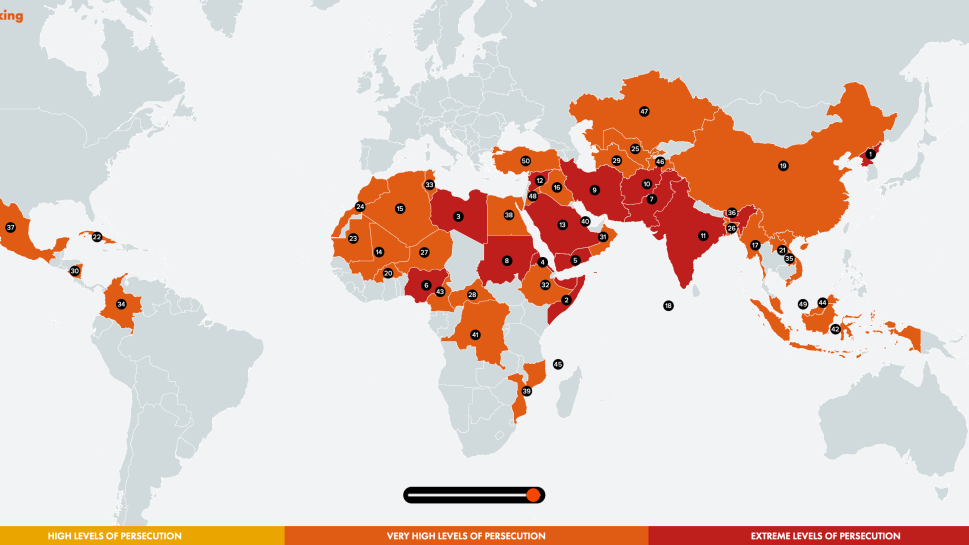Anno Domini: Why Our Calendar Points to Jesus
Every time you write a date, you’re acknowledging a story that began over two thousand years ago.
The letters AD that follow the number of our year stand for Anno Domini, a Latin phrase meaning “in the year of our Lord.”
But what does that really mean? How did Jesus’ life come to divide history itself and why does it still matter today?

The meaning of "Anno Domini"

Anno Domini nostri Iesu Christi translates to “in the year of our Lord Jesus Christ.” This phrase was chosen to mark the years following the birth of Jesus as a declaration that time itself belongs to Him.
In this system, years before Jesus’ birth are labeled BC (Before Christ) and those after are AD. Interestingly, there is no year 'zero'. The calendar moves directly from 1 BC to AD 1. Today, some prefer to use BCE (Before Common Era) and CE (Common Era), which follow the same numbering but remove the explicit reference to Christ. Nonetheless, even these abbreviations rely on the same point in time: The birth of Jesus Christ.
How the “Year of Our Lord” Began
The AD system wasn’t used in Jesus’ lifetime. It was introduced centuries later by a sixth-century monk named Dionysius Exiguus. Around AD 525, Dionysius was asked to calculate the dates of Easter. Instead of using the Roman system, which was named years after emperors (including the notorious persecutor Diocletian), Dionysius proposed something radical: A calendar centered on Christ’s birth.
By restructuring history around Jesus, Dionysius made a profound theological statement: That all of time finds its meaning in Him.
From a Monastic Table to a Global Calendar
The new system spread slowly at first. It was the Venerable Bede, an English monk in the 8th century, who popularized Anno Domini through his Ecclesiastical History of the English People. Later, Charlemagne adopted the dating method for official documents across his empire, ensuring that it became standard throughout Western Europe.
Over time, even secular historians and governments began using it. The Gregorian calendar reform of 1582, which corrected errors in the old Julian system, maintained the same AD/BC framework. This was a sign that, despite scientific precision and political power, the story of Jesus remained the reference point for time itself.
Debates and Discoveries
Modern scholars now believe that Jesus was likely born a few years earlier than Dionysius calculated (approximately around 6 to 4 BC), which is based on the reign of King Herod mentioned in the Gospels. This means the “first year of our Lord” might actually be several years after His true birth. Still, this doesn’t change the symbolic power of the dating system: It’s a calendar built not on perfect mathematics, but on divine meaning.
Even as many institutions shift to BCE/CE for inclusivity purposes, the numbering remains unchanged. We can see this as a subtle reminder that the dividing line of history is still the moment when Jesus entered the world.
Why “Anno Domini” Still Matters
Beyond history and linguistics, Anno Domini carries deep spiritual weight. Every birth certificate, calendar and headline testifies to His influence.
When you read “AD 2025,” you’re not just counting years but proclaiming that we still live “in the year of our Lord.” Even those who do not follow Him are living in a world shaped by His teachings which are premised on compassion, forgiveness and human dignity. For believers, that phrase is more than a date. It’s a daily invitation: To live in the reality that Christ’s life, death and resurrection are not ancient myths but a beautiful metaphor of the heartbeat of our history.
In Every Year, His Story Continues
Two thousand years later, the message of Anno Domini still stands.
Empires have fallen, languages have adapted and calendars have evolved. However, time itself continues to bear witness to the One who divided it in two.
Every sunrise you see is another day in the year of our Lord.
Maybe, this is history’s most powerful confession.
Who is Jesus anyway?
The Life of Jesus
Jesus lived in a very interesting moment in history. The Middle East was a hotbed of political and religious forces. There were many other revolutionaries in his time, but Jesus was not the typical leader. His movement was not a hostile, political one attempting to regain power for the nation of Israel, but one of peace and love.
Watch movie 'The Life of Jesus'
A wonderful movie about the life of Jesus Christ, following the gospel of John verse by verse. Watch the movie for free.
You may have heard the expressions 'Love your enemies' or 'turn the other cheek', those are sayings from Jesus himself. You can imagine the world would be quite different if we were all able to follow these simple, yet hard teachings.
Message of Jesus
Often Jesus favoured using stories to illustrate what the kingdom of God is like. He used parables to demonstrate the difference between God's kingdom and the world's kingdoms. Time and time again hinting at the striking contrast between what is and what will be, when all things are restored according to the purposes of God. Love is the message. Love is the way. God's love for you. Your love for God. Your love for others. This is the message Jesus came to tell us.
Love is the way
In 2018 bishop Michael Curry preached at the royal wedding of Prince Harry and Meghan Markle. 'There's power in love, don't underestimate it!' Millions of people listened. Watch it too!
Death and Resurrection
Jesus' message was focused on God's love. So why did people kill Jesus? Not everybody liked him, his message of forgiveness and hope. Not everybody did like his actions either. Some religious leaders of his time didn't like that he was 'a friend of sinners'. In the end, he was falsely convicted as a criminal. Blasphemy was charged to him. The religious elite saw a great resignation in the message of Jesus. (Mark 14:55-64)
Jesus is crucified
Even during his suffering on the cross Jesus chose love. He forgave the criminal who was convicted and executed at the same time. He prayed for the people who crucified him.
Jesus is rise!
The Bible tells an extraordinary story. Jesus rose from the stone grave they put him in. The story didn't end with his death. He is alive. Hundreds of people witnessed that he is alive. Christians believe he still is! (1 Corinthians 15:3-8)
Birth Of The Church
There were often uprisings in history. Also in the Biblical times. In the centuries around year zero, there were several rebellious groups in Israel, trying to regain power. After a leader of these groups was arrested and killed, the groups appointed a new leader or the revolution died out.
But after the death of Jesus, this didn't happen. People believed Jesus was alive, they didn't need another leader. This is the main reason why there is until today still a vibrant church living out the same conviction: Jesus lives!
Suffering because of faith
From the beginning being a follower of Jesus wasn't without risks. Many believers had to suffer because of their faith or were even martyred.
One story of a modern-day martyr is Father Frans van der Lugt, a Jesuit priest who was born and raised in the Netherlands and who lived and worked in Syria for several decades. He was killed there on April 7, 2014, in the city of Homs, aged 75. In his life, he established a community centre and farm near the city of Homs, Syria, where he worked for the betterment of people with disabilities and for harmony among Christian and Muslim people. Mid-2011 he left the estate because of the Syrian civil war and he established himself in the Jesuit monastery in the Christian district Bustan al-Diwan in Homs. Father Frans van der Lugt, a Dutch Jesuit priest, was abducted by armed men and then shot twice in the head on 7 April 2014 in Homs, Syria. He had refused to leave Homs during the civil war, choosing to stay with both Christians and Muslims who were besieged.
Modern-day Persecution
Christian organization Open Doors is reporting every year the countries where believing in Jesus will get you at risk (see the report). In 2024 these countries are in the top 5 of the list: North Korea, Somalia, Libya, Eritrea and Yemen.

Jesus' influence is everywhere
Did you notice that throughout history the church was taking care of the poor, the widowed, the orphans and the ill? The names of many hospitals are referring to their Christian origin, like Deaconess Hospital, St. Vincent's Hospital, St. Joseph's Hospital and Hospital of St John and St Elizabeth. The care for the outcasts, like the work of Mother Teresa in Calcutta and the work of Salvation Army worldwide is inspired by the story of Jesus who showed that the broken were his priority! Christian's have also been influential in the fight to educate the underprivileged all over the world for centuries.
Stories of people inspired by Jesus
Many people are touched, inspired or influenced by Jesus. For some people their encounter with Jesus was life-changing. Others simply decided to do what Jesus put on their hearts. Listen to some testimonies from people. Do you know what? You can be touched by Jesus too. Your life will never be the same!
Jesus and Politics
Jesus and Outcasts
Jesus and Religious leaders
Jesus and the Sick
Jesus' Friends
Jesus and Sinners
Jesus and Politics
Jesus often had confrontations with people in powerful positions. 'My Kingdom is not of this earth' he explained. That is hard to grasp for people who only understand what they can see with their eyes.
Jesus and Outcasts
Jesus seems to look at the world differently. People in power weren't that interesting to him. Instead, he sought out the marginalized people, the outcasts, the hated and ignored ones!
Jesus and Religious leaders
Even though much of Jesus' teaching centred around loving God and others, the religious leaders of his time did not like it. They felt it threatened their place of power. Often they attacked him, trying to find some error so they could publicly condemn him.
Jesus and the Sick
For Jesus, there is a special place for suffering and sick people. There are myriads of stories in the Bible where he does miracles; touching the infectious sick, healing them, opening the eyes of the blind and causing lame people to walk. He even raised the dead! (Matthew 8:14-17, Matthew 9:27-31, Mark 2:1-12, John 11:1-44)
Jesus' Friends
Jesus had a group of loyal friends around him, known as his disciples, followers, both men and women. These people were close to him, and with them he was able to talk plainly. After his resurrection, these disciples carried on his mission, spreading his teachings throughout the world. They witnessed his life, death, and resurrection firsthand, which became the foundation for the Gospel accounts-Matthew, Mark, Luke, and John. Through their writings, the disciples provided detailed testimonies of Jesus’ words, miracles, and acts of love, ensuring that his message would reach generations far beyond those who walked with him.
Jesus and Sinners
What did Jesus do with individuals condemned as sinners? He spent time with them, ate in their homes. The religious leaders tried to trap him with questions in regards to a woman caught in sin. But Jesus flipped the question on them, revealing their own sin. Even then he didn't judge. He forgave sin. (Luke 7:36-50, John 8:1-11, Matthew 9:10-13, Mark 2:15-17)
What about you?
What do you think about Jesus? Do you want to know more about this world altering, life changing man? We have many more resources available for you to continue your journey of exploring who Jesus is.

Timeline of Jesus' Life on Earth
Jesus, the man who changed time itself. From His birth celebrated at Christmas to His death and resurrection remembered on Good Friday and Easter, His life continues to shape the world. Who was He really, and what story does history tell? Discover the defining moments of Jesus’ life here.




